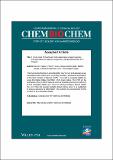A novel class of fluorinated A2A adenosine receptor agonist with application to last step enzymatic [18F]fluorination for PET imaging
Date
02/11/2017Author
Grant ID
EP/I034734/1
EP/M01262X/1
BBS/B/04579
Keywords
Metadata
Show full item recordAbstract
The A2A adenosine receptor belongs to a family of G-coupled protein receptors that have been subjected to extensive investigation over the last few decades. Due to their prominent role in the biological functions of the heart, lungs, CNS and brain, they have become a target for the treatment of illnesses ranging from cancer immunotherapy to Parkinson's disease. The imaging of such receptors using positron emission tomography (PET) has also been of interest, potentially providing a valuable tool to analyse and diagnose various myocardial and neurodegenerative disorders, as well as offering support to drug discovery trials. Reported herein is the design, synthesis and evaluation of two novel 5'-fluorodeoxy-adenosine (FDA) based receptor agonists (FDA-PP1 and FDA-PP2), each substituted at the C-2 position with a terminally functionalised ethynyl unit. The structures enable a synthesis of 18F-labelled analogues via direct, last-step, radiosynthesis from chlorinated precursors using the fluorinase enzyme (5'-fluoro-5'-deoxyadenosine synthase) which catalyses a transhalogenation reaction. This delivers a new class of A2A adenosine receptor agonist which can be directly radiolabelled for exploration in PET studies.
Citation
Lowe , P T , Dall'Angello , S , Mulder-Krieger , T , Ijzerman , A P , Zanda , M & O'Hagan , D 2017 , ' A novel class of fluorinated A 2A adenosine receptor agonist with application to last step enzymatic [ 18 F]fluorination for PET imaging ' , ChemBioChem , vol. 18 , no. 21 , pp. 2156-2164 . https://doi.org/10.1002/cbic.201700382
Publication
ChemBioChem
Status
Peer reviewed
ISSN
1439-7633Type
Journal article
Description
The authors thank the Engineering and Physical Sciences Research Council, UK, for a research grant.Collections
Items in the St Andrews Research Repository are protected by copyright, with all rights reserved, unless otherwise indicated.

